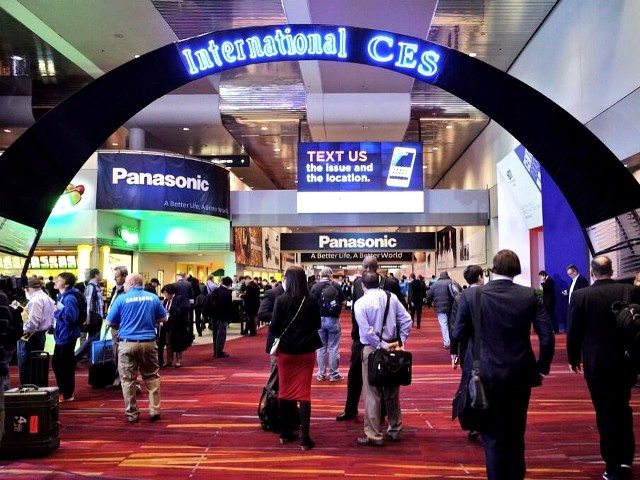Every year, pundits and Apple-focused writers make the point that, while Apple is absent from CES, their products and presence are still very much at CES. My friend Avi made this astute point in a tweet:

Even this VentureBeat headline drives the point home: “How Apple Won CES again — without showing up“. Unquestionably, Apple products were everywhere at every booth of essentially every company doing something cool or interesting. But just this point alone is not the most interesting one. What CES and Apple’s large presence here is truly highlighting is the growth and strength of the Apple ecosystem.
Now, it sounds counter-intuitive to say we can go to a non-Apple show where Apple itself does not have a booth or any official involvement and make a claim it is the place to go and see the best and brightest parts of their ecosystem. We used to have a show called Macworld Expo we would go to and see the full Apple ecosystem. But in all honestly, this is largely what the CES show floor has become.
In fact, I made the point in a discussion last night about the dedicated iProducts Marketplace for iOS-specific accessories. It has become largely irrelevant — nearly every booth was only showing off their products working with iPhones or iPads. The CES show floor has essentially become, or at least it felt like for me observationally, a giant Apple ecosystem showcase. So the question is why and what does that mean going forward.
The why seems relatively simple. Everyone showing off their connected products — connected clothing, shirts, socks, apparel with sensors, connected health, connected home, connected sports, robots, drones, smart watches, wearables, connected cars, connected light bulbs, pretty much everything connected — was demoing using apps on the iPhone and iPad. Now, this is not to say the only thing you can use them with is an iPhone. Of course many offer an Android app. But this does signal to us who is their target buyer. Because Apple has a near monopoly on the most profitable global consumer base, these companies know that, in all likelihood, it is iOS customers who are the most likely to buy their products.
This is interesting and, as I’ve pointed out many times, it feels like there is a real divide clearly happening between the Android ecosystem and the iOS ecosystem. Apple has customers who can and will spend money around the ecosystem and Android increasingly does not, especially as their installed base increases in the extreme low end of the smart phone market.
There are companies at CES supporting Android but support for the platform was publicly, and tellingly, de-emphasized. Interestingly, many companies were making products you plugged your phone into to make it “smart”. I saw several bicycles with iPhone connectors, iPhone-connecting treadmills, health accessories like a glucose monitor, and many other products. Some required the device to be plugged in but weren’t using Bluetooth and all were iPhone only. The key point here is the buying power of Apple’s customer base is genuinely impacting the decisions and strategies of many companies making connected products.
The other fascinating point is Apple’s continued gain of iOS share in developed markets. It is no secret when it comes to the market strategies of nearly all tech companies the West is their primary focus. Recent data from Kantar highlights more evidence for my prediction that iOS will be the majority smartphone platform in the US. With iOS getting stronger in developed countries and many of these connected products companies targeting iOS users, it may very well have a larger impact on the Android platform in these markets than many assume.

Maybe this is so obvious it’s not worth mentioning, but seems like hardware ecosystem seeing the same pattern of app ecosystem? Further extends
Agree. That is essentially the point I was making. While it was obvious in the early days of the iPhone/iPad it is getting even bigger with this IoT category.
That’s a frightening concept. Simply my PC being locked-in to MS OS and Office already developed into a pain over the years (expensive software, stagnant OS, malware…); if my house, car, treadmill, health and kitchen appliances get locked-in too, I can only imagine how bad and expensive things will get in a decade.
I believe we’re already there. If you look at the array of products and services you use you’ll find very little diversity.
Google owns the market in search, maps and video (via YouTube) so most of what consumers do on a daily basis involves Google in some for or another. That’s one company in control of a significant portion of what consumers and corporations do/access on a daily basis.
I’ve just learned to adapt to the fact that if you want the best technology has to offer you’re gonna be dealing with only a handful of companies. And with both Google and Apple buying up most everyone and everything the trend will only expand.
But that’s the world we live in: mergers and acquisitions. The days of Ma & Pa operations are far and few between. Case in point: not even video games are safe from conglomerates with Microsoft paying $3 billion for Minecraft and Samsung attempting to buy out Blackberry.
It’s not quite the same though: I can easily change search engines, map providers, even for video, there are a few alternatives. And for all these 3, there is no lock-in, and few network effects, at the user level.
Having my locks, lights, kitchen/washroom, car, electronics… require an iDevice is a completely different proposition.